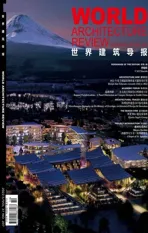中意文化交流中心之中华馆
2022-11-16存在建筑

建筑设计:aoe 事建组 | 主创设计师:温群 | 地点:中国 | 时间:2021 年 | 摄影:存在建筑
Design Company: aoe | Chief designer: Wen Qun | Location: China | Date: 2021 | Photo credits: Arch-Exist Photography
中华馆位于中意文化交流中心的东面,从中意馆穿过竹林环抱的文化长廊即可到达。馆内由多功能厅、会议室、餐厅、琴亭及茶室等功能组成,充满了东方韵味。设计之初,建筑师希望在中西文化差异的形态中找到两者的交点:场地总体布局概念取自我国自古用以馈赠外国使臣的“如意”,以示缔结友好关系,寓意两国国泰民安。东西两馆以文化长廊为连接,环抱水塘及竹林。中华馆与中意馆以意大利广场为空间原型相对应,通过景、形、意、情的营造,诠释了东方世界天人合一的文化哲学。
场地原址为一片竹林,西侧贴临水塘。以最大限度保留竹林,将建筑融入竹林为出发点,功能散落竹林各处,院墙分隔内外庭院。内部穿插三处庭院,使室内空间,庭院,竹林形成互望对景之势。院内布置中式现代景观园林,创造独有的内景天地。踏入竹林,拾级而下,掩映在竹林之下的琴房若隐若现,琴声、风声、竹叶的摇曳声、竹林下跳动的光影融为一体。探出竹林,茶室漂浮于水塘之上,日光充盈,豁然开朗,西望中意馆倒映在柔静的睡莲池中。


建筑形态采用了传统的木制构架,进行现代转译,引入圆形几何元素。连续的十字形拱柱由室内向室外延绵推进,通透玻璃幕墙消除了室内外边界,自然地将室外景色带入室内。室外连续圆形镂空廊架,塑造富于变化及静谧的光影体验。院墙由文化长廊延伸而来,穿行竹林之间,将屋舍串联,形似中国书法的写意与松弛。院墙的对景窗洞形似水滴,取义自然。中华馆由屋,院,廊,景构成,建筑以退让之势,融入自然。“景”作为建筑不可分割的要素,建筑源于景,生于景,融于景,终成为景的一部分。充分体现了道法自然,天人合一的东方智慧。中华馆通过对自然的尊重与利用,将空间融入光,风,声,嗅觉等自然要素。形成赋予东方韵味的情感记忆。同时也是对中意文化交流最好的呈现。
The Chinese Cultural Hall is located to the east of the Sino-Italian Cultural Exchange Center.It can be reached from the Sino-Italian Pavilion through the cultural corridor surrounded by bamboo forests.The chinese cultural hall is composed of multifunctional halls,meeting rooms,restaurants,piano pavilions and tea rooms,the design is full of oriental charm.At the beginning of the design,the architect hoped to find the intersection of the two in the form of Chinese and Western cultural differences: the overall layout concept of the site was taken from the "ruyi" that China used to gift foreign envoys since ancient times to signify the establishment of friendly relations and imply the peace of the two countries.The east and west pavilions are connected by a cultural corridor,it surrounded by ponds and bamboo forests.The Chinese Cultural Hall and the Chinese-Italian Cultural Hall use Italian squares as their spatial prototypes.Through the creation of scenery,form,meaning and emotion,they interpret the cultural philosophy of the harmony between man and nature in the Eastern world.


Scenery: The original site of the site is a bamboo forest with a pond on the west side.The starting point is to preserve the bamboo forest as much as possible and integrate the building into the bamboo forest.The functions are scattered throughout the bamboo forest,and the courtyard wall separates the inner and outer courtyards.Three courtyards are interspersed inside,so that the indoor space,courtyard and bamboo forest form a tendency to look at each other.A Chinese-style modern landscape garden is arranged in the courtyard to create a unique interior landscape.Stepping into the bamboo forest,stepping down,the piano room hidden under the bamboo forest is looming,the sound of the piano,the sound of wind,the swaying sound of bamboo leaves and the light and shadow dancing under the bamboo forest are integrated.Out of the bamboo forest,the tea room floats above the pond,full of sunlight,suddenly enlightened,and looking to the west,the Zhongyi Pavilion is reflected in the quiet water lily pond Form: The architectural form adopts traditional wooden frame to carries out modern translation and use circular geometric elements.The continuous cross-shaped arch column extends from the interior to the exterior and the transparent glass curtain wall eliminates the boundary between the interior and the exterior,it naturally brings the outdoor scenery into the interior.The outdoor continuous circular hollow corridor frame creates a varied and quiet light and shadow experience.The courtyard wall extends from the cultural corridor,passing through the bamboo forests,connecting the houses in series,resembling the freehand brushwork and relaxation of Chinese calligraphy.The opposite view window hole on the courtyard wall is shaped like a drop of water,taking the meaning of nature.


